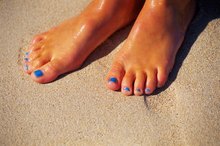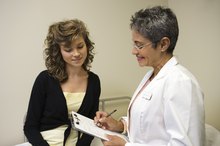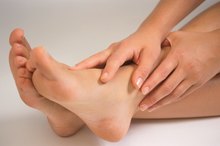What does fact checked mean?
At Healthfully, we strive to deliver objective content that is accurate and up-to-date. Our team periodically reviews articles in order to ensure content quality. The sources cited below consist of evidence from peer-reviewed journals, prominent medical organizations, academic associations, and government data.
The information contained on this site is for informational purposes only, and should not be used as a substitute for the advice of a professional health care provider. Please check with the appropriate physician regarding health questions and concerns. Although we strive to deliver accurate and up-to-date information, no guarantee to that effect is made.
Bumps in a Circle on the Skin
Bumps on the skin shaped like a circle, also known as ringworm, is a common skin issue typically among children; however, anyone can develop ringworm. Ringworm develops when you become infected with a type of fungus that grows and quickly multiplies on your body, including the skin, nails and scalp area. This condition also causes itchiness and discomfort.
If you are experiencing serious medical symptoms, seek emergency treatment immediately.
Causes
Ringworm is a type of fungal infection that becomes a parasite on your body. The mold lives on the outside of the body, forming a ring shape. Ringworm is contagious and is spread through skin-to-skin contact with an infected person, animal to human contact or object to human contact. Ringworm is also spread through contact with infected soil; however, this is less common. Those who have a weak immune system are at higher risk for developing ringworm, according to the American Academy of Dermatology 3. A weak immune system will also make symptoms more severe.
- Ringworm is a type of fungal infection that becomes a parasite on your body.
Treatments
Itchy Skin Between the Toes
Learn More
Nonprescription treatments, such as:
- clotrimazole
- terbinafine
- miconazole
- tolnaftate
- are used to treat ringworm
These treatments are available in creams and applied to the circle skin bumps daily. Wash and dry the area before applying the cream and use twice daily for at least two weeks, recommends the Mayo Clinic 1.
Considerations
If ringworm doesn’t get better after two weeks of nonprescription treatments, contact your doctor. She can prescribe stronger treatment options, such as topical butenafine, econazole or terbiafine creams. Oral prescription medications are also available, including griseofulvin, fluconazole and terbinafine. Oral medications, however, have side effects, including stomach upset and liver functioning abnormalities. Talk with your doctor about side effects before taking the medication.
- If ringworm doesn’t get better after two weeks of nonprescription treatments, contact your doctor.
- She can prescribe stronger treatment options, such as topical butenafine, econazole or terbiafine creams.
Prevention
Ringworm Life Cycle
Learn More
Prevent ringworm by not sharing personal items such as hairbrushes and towels. Avoid wearing thick clothes for extended periods of time, which creates a moist environment for ringworm to grow. Shower after intense activity and wash your hands often. Ringworm can also affect the feet. When using a public area, such as gym locker room or community pool, wear sandals to protect your feet from ringworm.
- Prevent ringworm by not sharing personal items such as hairbrushes and towels.
- Avoid wearing thick clothes for extended periods of time, which creates a moist environment for ringworm to grow.
Warnings
If you take the oral prescription warfarin, talk with your doctor before taking oral medications for ringworm. This drug has interactions with oral medications used to treat ringworm. Always tell your doctor all the medications you’re taking to prevent potential interactions.
Related Articles
References
- Mayo Clinic: Ringworm
- MedlinePlus: Ringworm
- American Academy of Dermatology: Fungal Infections on the Skin
- Cornell University College of Veterinary Medicine. Ringworm: A Serious but Readily Treatable Affliction. 2018.
- Centers for Disease Control and Prevention. Ringworm Information for Healthcare Professionals. Updated February 6, 2020.
- Ely JW, Rosenfeld S, Seabury Stone M. Diagnosis and management of tinea infections. Am Fam Physician. 2014;90(10):702-710.
- American Academy of Dermatology. “Ringworm: Diagnosis, Treatment, and Outcome.”
- Laniosz V, Wetter DA. "What's New in the Treatment and Diagnosis of Dermatophytosis?" Seminars in Cutaneous Medicine and Surgery. 2014 Sep;33(3):136-9.
Writer Bio
Nicki Howell started her professional writing career in 2002, specializing in areas such as health, fitness and personal finance. She has been published at health care websites, such as HealthTree, and is a ghostwriter for a variety of small health care organizations. She earned a Bachelor of Science in business administration from Portland State University.







